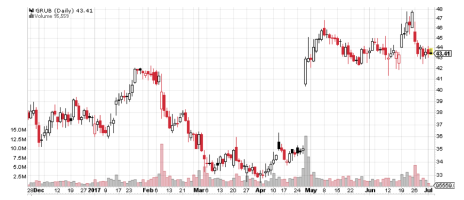As Chief Analyst of Cabot Global Stocks Explorer, I sometimes get phone calls from subscribers asking about the market or how to handle individual growth stocks. I’m always happy to talk about stocks (and to listen to what’s on investors’ minds). And I always sign off the same way: “Good luck!”
I wonder sometimes if my callers think that’s odd. After all, I’m supposed to be an expert, so luck shouldn’t have anything to do with the success of my recommendations. I take away the stock market risk. Right?
So wrong!
[text_ad]
Buying stocks is always a risky business. And growth stocks, which have a higher potential for big gains, are correspondingly prone to big losses. The marriage of stock market risk and reward is a solid one; they never split up and seldom even argue. If you think of the stock market as a giant calculator of perceived value, then the collective wisdom mandates that risk and reward remain correlated.
And while Cabot’s approach to growth investing has a number of time-tested ways to improve the odds of success, there’s still an unavoidable chance that any given stock pick may go wrong. And that means that your ultimate success as a growth investor always has an element of luck in it. It’s the law.
For instance, now that July is here and the second calendar quarter is on the books, companies will be reporting their results in an increasing torrent over the next six weeks or so.
It used to be that a canny observer, watching a stock’s chart closely, could get a hint about whether or not a company was going to meet (or beat) the all-important analysts’ expectations. The uptick (or downtick) in the stock represented buying or selling by stock insiders, which meant the company’s executives and their friends and neighbors.
But the FTC got to be as sensitive to that kind of anomalous trading as the savviest speculator. And the specter of prosecution for insider trading put a damper on that kind of informed anticipation.
It’s relatively easy to figure out whether a company’s revenue and earnings will increase or decrease. Any good fundamental analyst can pull that off.
But knowing whether the increase or decrease will fall short of, meet or beat the consensus among analysts is a much trickier proposition. And the results can be dramatic. Here’s what happened to GrubHub (GRUB), the online takeout food facilitator when it reported its quarterly results on April 27. The stock, which had been stuck in the mud after a February correction, flashed from 35 at the close on April 26 to 42 in just one day. The jump came on huge volume, and the stock has held those gains.
I’ll spare your feelings from showing a similarly steep decline after an earnings report that missed expectations, but you’ve probably seen it happen often enough.
Quarterly earnings are the most common source of big moves, but they’re not the only one. For pharmaceutical stocks, the results of clinical trials can be every bit as powerful. Here’s a chart for Clovis Oncology (CLVS), a company that develops treatments for difficult cancers. In June, the company got good news from a late third-stage clinical trial for its ovarian cancer drug Rubraca. Again, you see the massive volume spike—from about two million shares traded the previous day to nearly 14 million on June 19—and a close-to-close price move from 60 to 88.
While the price move hasn’t been as dramatic, one of the holdings in Cabot Global Stocks Explorer just took a small hit from an unexpected source. The company is Tencent Holdings (TCEHY), an online giant that dominates the instant messaging and chat market among Chinese mobile phone users. The stock dipped about 3% on Wednesday after the Chinese government criticized one of its online games for spreading “negative energy” and being a “poison” and a “drug.”
TCEHY has been in a steady uptrend since late December, and its Wednesday dip didn’t drop the stock below its recent trading range, but it’s still a surprise. And it’s a surprise that anyone who bought at the stock’s June high of 37 won’t appreciate. Here’s what the chart looked like on Wednesday morning.
Anyone who uses a small growth portfolio (like the 10 stocks in the portfolios of Cabot Growth Investor and Cabot Global Stocks Explorer) knows that the bulk of a year’s gains will come from the action of a very small number of stocks. You buy stocks that have great stories, numbers and charts, cut your losses short and let your winners run and regulate your aggressiveness or defensiveness by the momentum of the market.
You can do everything right and occasionally get whacked by the unexpected and unpredictable, or do everything wrong and come out smelling like a rose. But eventually, luck will favor those who do things right. And doing things right is what Cabot is all about. Our experience can be your guide (and improve your luck). Click here to find out how.
[author_ad]




